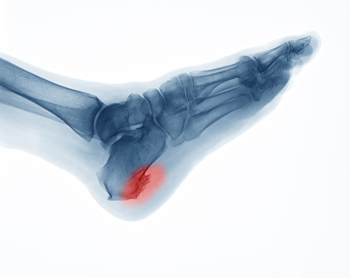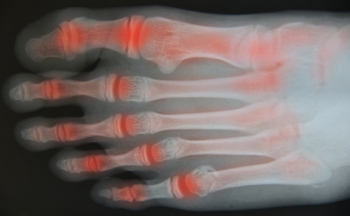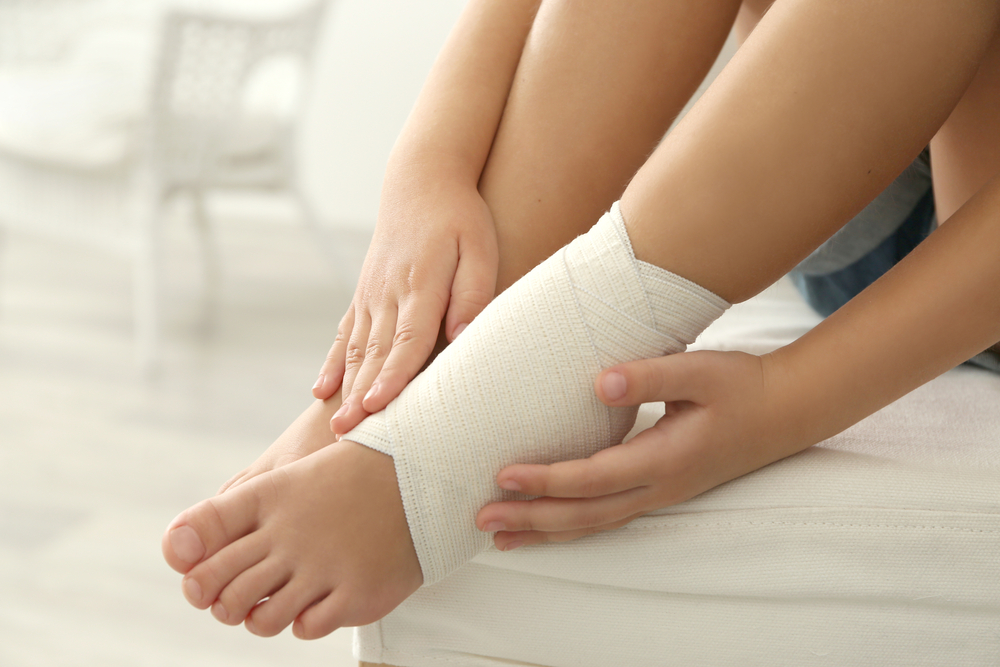Connect With Us
Blog
Items filtered by date: June 2021
Who Gets Sever's Disease?
 Sever’s disease, also known as calcaneal apophysitis, is an injury of the growth plate in the heel bone that is caused by repetitive trauma to the area. It often affects both heels simultaneously. This condition is most common among children and adolescents between the ages of 9 and 12 as they go through a rapid growth spurt. Sever’s disease occurs more often in males than females. Children who participate in sports that require frequent running and jumping, such as basketball, soccer, track, cross-country, and gymnastics are most at risk. If your child complains of heel pain or is walking with a limp, it is suggested that you take them to see a podiatrist who can diagnose and treat their condition.
Sever’s disease, also known as calcaneal apophysitis, is an injury of the growth plate in the heel bone that is caused by repetitive trauma to the area. It often affects both heels simultaneously. This condition is most common among children and adolescents between the ages of 9 and 12 as they go through a rapid growth spurt. Sever’s disease occurs more often in males than females. Children who participate in sports that require frequent running and jumping, such as basketball, soccer, track, cross-country, and gymnastics are most at risk. If your child complains of heel pain or is walking with a limp, it is suggested that you take them to see a podiatrist who can diagnose and treat their condition.
Sever's disease often occurs in children and teens. If your child is experiencing foot or ankle pain, see Scott Matthews, DPM, MD from Salem Foot Care . Our doctor can treat your child’s foot and ankle needs.
Sever’s Disease
Sever’s disease is also known as calcaneal apophysitis, which is a medical condition that causes heel pain I none or both feet. The disease is known to affect children between the ages of 8 and 14.
Sever’s disease occurs when part of the child’s heel known as the growth plate (calcaneal epiphysis) is attached to the Achilles tendon. This area can suffer injury when the muscles and tendons of the growing foot do not keep pace with bone growth. Therefore, the constant pain which one experiences at the back of the heel will make the child unable to put any weight on the heel. The child is then forced to walk on their toes.
Symptoms
Acute pain – Pain associated with Sever’s disease is usually felt in the heel when the child engages in physical activity such as walking, jumping and or running.
Highly active – Children who are very active are among the most susceptible in experiencing Sever’s disease, because of the stress and tension placed on their feet.
If you have any questions, please feel free to contact our office located in Wikesboro, NC . We offer the newest diagnostic and treatment technologies for all your foot and ankle injuries.
What Are Sesamoids and Are They Important?
Although they are small, the two sesamoid bones within the tendon under the big toe joint have three big responsibilities. First, they act as weight-bearing aids to the first metatarsal bone. Secondly, they facilitate normal movement of the big toe. Lastly, they help the big toe push off adequately during running and walking. Sesamoiditis can occur when these pea-sized bones and their associated tendons become inflamed due to overuse or other conditions that place excessive pressure on the ball of the foot. Some of these activities and contributing factors may include running, ballet, tennis, basketball, football, wearing high heels, and having high arches. If you have fluctuating pain under your big toe, a podiatrist can examine you and may perform various imaging studies to determine if you have sesamoiditis. Treatment for sesamoiditis may include various techniques to keep weight off of the foot and relieve tension in the affected area, oral or injectable medications to reduce pain and swelling, custom orthotics to redistribute pressure on the ball of the foot, rehabilitative therapies, or even surgery if the condition does not respond to more conservative treatments.
Sesamoiditis is an unpleasant foot condition characterized by pain in the balls of the feet. If you think you’re struggling with sesamoiditis, contact Scott Matthews, DPM, MD of Salem Foot Care . Our doctor will treat your condition thoroughly and effectively.
Sesamoiditis
Sesamoiditis is a condition of the foot that affects the ball of the foot. It is more common in younger people than it is in older people. It can also occur with people who have begun a new exercise program, since their bodies are adjusting to the new physical regimen. Pain may also be caused by the inflammation of tendons surrounding the bones. It is important to seek treatment in its early stages because if you ignore the pain, this condition can lead to more serious problems such as severe irritation and bone fractures.
Causes of Sesamoiditis
- Sudden increase in activity
- Increase in physically strenuous movement without a proper warm up or build up
- Foot structure: those who have smaller, bonier feet or those with a high arch may be more susceptible
Treatment for sesamoiditis is non-invasive and simple. Doctors may recommend a strict rest period where the patient forgoes most physical activity. This will help give the patient time to heal their feet through limited activity. For serious cases, it is best to speak with your doctor to determine a treatment option that will help your specific needs.
If you have any questions please feel free to contact our office located in Wikesboro, NC . We offer the newest diagnostic and treatment technologies for all your foot and ankle needs.
Types of Heel Pain a Podiatrist Can Treat
 Heel pain can develop due to a variety of sources or causes, and can impact everyday life. The most common cause of heel pain is plantar fasciitis which occurs when the plantar fascia (the tissue that runs along the bottom of the foot connecting the heel to the toes) becomes inflamed. Heel spurs are another way heel pain may occur. This condition may occur when there is an abnormal bone growth where the plantar fascia and heel bone attach. Other painful heel conditions include calcaneal apophysitis (where the heel bone is irritated from new shoes or athletic activity), bursitis (inflammation of the sac that lines many joints), or a trapped nerve (when the nerves become compressed). Patients who are struggling with heel pain should consult with a podiatrist. A podiatrist will assess details regarding your pain, medical history and lifestyle. A podiatrist will also examine your gait, feet, and nerves to diagnose the source of heel pain and provide the best treatment.
Heel pain can develop due to a variety of sources or causes, and can impact everyday life. The most common cause of heel pain is plantar fasciitis which occurs when the plantar fascia (the tissue that runs along the bottom of the foot connecting the heel to the toes) becomes inflamed. Heel spurs are another way heel pain may occur. This condition may occur when there is an abnormal bone growth where the plantar fascia and heel bone attach. Other painful heel conditions include calcaneal apophysitis (where the heel bone is irritated from new shoes or athletic activity), bursitis (inflammation of the sac that lines many joints), or a trapped nerve (when the nerves become compressed). Patients who are struggling with heel pain should consult with a podiatrist. A podiatrist will assess details regarding your pain, medical history and lifestyle. A podiatrist will also examine your gait, feet, and nerves to diagnose the source of heel pain and provide the best treatment.
Many people suffer from bouts of heel pain. For more information, contact Scott Matthews, DPM, MD of Salem Foot Care . Our doctor can provide the care you need to keep you pain-free and on your feet.
Causes of Heel Pain
Heel pain is often associated with plantar fasciitis. The plantar fascia is a band of tissues that extends along the bottom of the foot. A rip or tear in this ligament can cause inflammation of the tissue.
Achilles tendonitis is another cause of heel pain. Inflammation of the Achilles tendon will cause pain from fractures and muscle tearing. Lack of flexibility is also another symptom.
Heel spurs are another cause of pain. When the tissues of the plantar fascia undergo a great deal of stress, it can lead to ligament separation from the heel bone, causing heel spurs.
Why Might Heel Pain Occur?
- Wearing ill-fitting shoes
- Wearing non-supportive shoes
- Weight change
- Excessive running
Treatments
Heel pain should be treated as soon as possible for immediate results. Keeping your feet in a stress-free environment will help. If you suffer from Achilles tendonitis or plantar fasciitis, applying ice will reduce the swelling. Stretching before an exercise like running will help the muscles. Using all these tips will help make heel pain a condition of the past.
If you have any questions please contact our office located in Wikesboro, NC . We offer the newest diagnostic and treatment technologies for all your foot and ankle needs.
Psoriatic Arthritis and the Feet
 Psoriatic arthritis is an autoimmune disease that causes pain, stiffness, and swelling in your joints. This particular type of arthritis affects 10-30% of people who have psoriasis, a skin condition characterized by the formation of dry, scaly, itchy patches of skin. Psoriatic arthritis often affects the small joints of the feet. It can also cause enthesitis, inflammation in the areas where the tendons or ligaments connect to bones. This often occurs in the Achilles tendon or the plantar fascia along the bottom of the foot, and makes the areas tender, swollen, and painful. If you have psoriatic arthritis in your feet or ankles, a podiatrist can help you manage and maintain your foot health.
Psoriatic arthritis is an autoimmune disease that causes pain, stiffness, and swelling in your joints. This particular type of arthritis affects 10-30% of people who have psoriasis, a skin condition characterized by the formation of dry, scaly, itchy patches of skin. Psoriatic arthritis often affects the small joints of the feet. It can also cause enthesitis, inflammation in the areas where the tendons or ligaments connect to bones. This often occurs in the Achilles tendon or the plantar fascia along the bottom of the foot, and makes the areas tender, swollen, and painful. If you have psoriatic arthritis in your feet or ankles, a podiatrist can help you manage and maintain your foot health.
Arthritis can be a difficult condition to live with. If you are seeking treatment, contact Scott Matthews, DPM, MD from Salem Foot Care . Our doctor can provide the care you need to keep you pain-free and on your feet.
Arthritic Foot Care
Arthritis is a joint disorder that involves the inflammation of different joints in your body, such as those in your feet. Arthritis is often caused by a degenerative joint disease and causes mild to severe pain in all affected areas. In addition to this, swelling and stiffness in the affected joints can also be a common symptom of arthritis.
In many cases, wearing ill-fitting shoes can worsen the effects and pain of arthritis. Wearing shoes that have a lower heel and extra room can help your feet feel more comfortable. In cases of rheumatoid arthritis, the arch in your foot may become problematic. Buying shoes with proper arch support that contour to your feet can help immensely.
Alleviating Arthritic Pain
- Exercises that stretch the foot can prevent further pain and injury and increase mobility
- Most of the pain can be alleviated with anti-inflammatory drugs, heat, and topical medications
- Massages can help temporarily alleviate pain.
It is best to see your doctor for the treatment that is right for your needs and symptoms. Conditions vary, and a podiatrist can help you determine the right method of care for your feet.
If you have any questions, please feel free to contact our office located in Wikesboro, NC . We offer the newest diagnostic tools and technology to treat your foot and ankle needs.
What Is a Medial Ankle Sprain?
An ankle sprain occurs when ligaments, the fibrous bands of tissue that connect bones to each other and stabilize joints, are overstretched or torn due to an injury. Most ankle sprains are lateral, affecting the ligaments along the outer edges of the ankle. A medial ankle sprain occurs when the ligament along the inner edge of the ankle is overstretched or torn. This is usually caused by a sudden twisting, turning, or rolling inward of the ankle. Symptoms may include pain on the inside of the ankle when moving or placing weight on it, swelling, bruising, and tenderness. If you suspect that you may have sprained your ankle, please see a podiatrist for a proper diagnosis and treatment plan.
Ankle sprains are common but need immediate attention. If you need your feet checked, contact Scott Matthews, DPM, MD from Salem Foot Care . Our doctor can provide the care you need to keep you pain-free and on your feet.
How Does an Ankle Sprain Occur?
Ankle sprains take place when the ligaments in your ankle are torn or stretched beyond their limits. There are multiple ways that the ankle can become injured, including twisting or rolling over onto your ankle, putting undue stress on it, or causing trauma to the ankle itself.
What Are the Symptoms?
- Mild to moderate bruising
- Limited mobility
- Swelling
- Discoloration of the skin (depending on severity)
Preventing a Sprain
- Wearing appropriate shoes for the occasion
- Stretching before exercises and sports
- Knowing your limits
Treatment of a Sprain
Treatment of a sprain depends on the severity. Many times, people are told to rest and remain off their feet completely, while others are given an air cast. If the sprain is very severe, surgery may be required.
If you have suffered an ankle sprain previously, you may want to consider additional support such as a brace and regular exercises to strengthen the ankle.
If you have any questions please feel free to contact our office located in Wikesboro, NC . We offer the newest diagnostic and treatment technologies for all your foot and ankle needs.
Blog Archives
- March 2025
- February 2025
- January 2025
- December 2024
- November 2024
- October 2024
- September 2024
- August 2024
- July 2024
- June 2024
- May 2024
- April 2024
- March 2024
- February 2024
- January 2024
- December 2023
- November 2023
- October 2023
- September 2023
- August 2023
- July 2023
- June 2023
- May 2023
- April 2023
- March 2023
- February 2023
- January 2023
- December 2022
- November 2022
- October 2022
- September 2022
- August 2022
- July 2022
- June 2022
- May 2022
- April 2022
- March 2022
- February 2022
- January 2022
- December 2021
- November 2021
- October 2021
- September 2021
- August 2021
- July 2021
- June 2021
- May 2021
- April 2021
- March 2021
- February 2021
- January 2021
- December 2020
- November 2020
- October 2020
- September 2020
- August 2020
- July 2020
- June 2020
- May 2020
- April 2020
- March 2020
- February 2020
- January 2020
- December 2019
- November 2019
- October 2019
- September 2019
- August 2019
- July 2019
- June 2019
- May 2019
- April 2019
- March 2019
- February 2019
- January 2019
- December 2018
- November 2018
- October 2018
- September 2018
- August 2018
- July 2018
- June 2018
- May 2018



